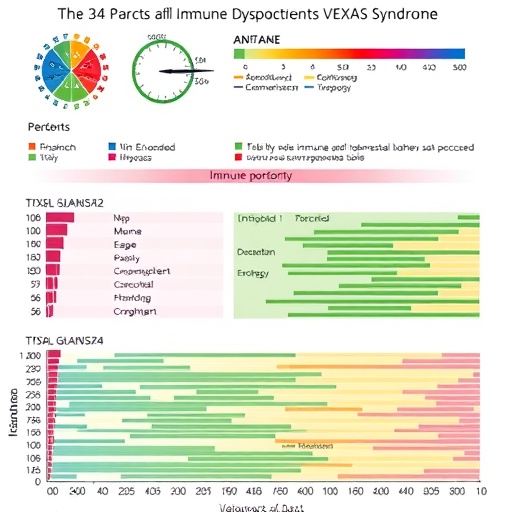In recent years, the medical community has grappled with understanding the complexities of VEXAS syndrome, a recently characterized autoinflammatory disorder predominantly affecting adult males. Despite its identification only a few years ago, VEXAS has confounded clinicians with its heterogeneous presentation and rapidly progressive course. A groundbreaking study published in Nature Communications by Mizumaki, Gao, Wu, and colleagues now sheds unprecedented light on the molecular underpinnings of this syndrome, employing in-depth transcriptomic profiling to reveal a detailed landscape of dysfunctional immune responses in affected patients.
VEXAS syndrome, an acronym for vacuoles, E1 enzyme, X-linked, autoinflammatory, somatic syndrome, arises from somatic mutations in the UBA1 gene that encodes the ubiquitin-activating enzyme E1. These mutations disrupt the ubiquitination pathway, a critical cellular process that tags proteins for degradation, thereby maintaining proteostasis and immune regulation. Understanding the downstream immune perturbations has remained challenging due to the rarity and complexity of the disease. The recent transcriptome analysis fundamentally advances this understanding by mapping gene expression alterations at a cellular level, providing rich mechanistic insight.
The study utilized high-throughput RNA sequencing of peripheral blood mononuclear cells (PBMCs) isolated from patients diagnosed with VEXAS syndrome and compared them to matched healthy controls. This unbiased, wide-spectrum approach enabled the identification of distinct transcriptional signatures and cell population dynamics that define the immunological dysfunction in VEXAS. The rigorous statistical models and bioinformatic pipelines implemented ensured the robustness of the findings, correlating clinical features with molecular profiles.
One pivotal revelation from the transcriptomic profiling was the profound dysregulation of myeloid lineage cells in VEXAS patients. Particularly, monocytes exhibited an aberrant activation state characterized by upregulated expression of pro-inflammatory cytokines and genes responsible for antigen presentation pathways. This hyperactivation likely contributes to the intense systemic inflammation observed clinically, manifesting with fevers, cytopenias, and bone marrow dysplasia. Additionally, neutrophilic granulocytes showed altered gene expression patterns associated with enhanced degranulation and reactive oxygen species production, further perpetuating tissue damage.
Concurrently, the study unveiled perturbations in lymphoid populations, specifically within subsets of T cells. There was evidence of exhaustion markers upregulation and skewing toward phenotypes indicative of chronic antigen exposure. These observations suggest that persistent inflammation drives T-cell dysfunction, potentially impairing adaptive immunity and predisposing patients to opportunistic infections. This lymphoid compartment dysfunction highlights the broader immune dysregulation beyond innate immunity components.
Notably, Mizumaki and colleagues uncovered transcriptional signatures implicating disrupted interferon signaling pathways, which are critical for antiviral responses and immunomodulation. The precise nature of interferon dysregulation varied among individual patients, suggesting heterogeneity in immune impairment. However, consistent attenuation or hyperactivation elements were observed across the cohort, underlining a pivotal role for interferon cascades in disease pathophysiology. These insights open potential avenues for targeted therapeutic interventions aimed at restoring immune balance.
The transcriptomic landscape also revealed aberrations in cellular metabolic pathways, particularly those governing mitochondrial function and oxidative phosphorylation. Specifically, immune cells exhibited signatures compatible with metabolic reprogramming, a feature increasingly recognized as integral in chronic inflammation and immune cell differentiation. This metabolic shift possibly sustains the hyperinflammatory milieu, supporting pathogenic immune cell persistence and activity.
An intriguing aspect of the study was the integration of transcriptomic data with clinical phenotyping and disease severity metrics. Machine learning algorithms allowed for stratification of patients based on molecular profiles, which corresponded with differences in organ involvement and treatment responses. This stratification suggests that transcriptomic profiling may serve as a prognostic tool, enabling personalized medicine approaches tailored to individual immune dysfunction patterns.
The authors meticulously detail the potential implications for novel therapeutic targets emerging from their findings. Inhibition of specific cytokine pathways, restoration of ubiquitin-proteasome system function, and modulation of metabolic circuits present viable strategies. Furthermore, the paper discusses how current therapeutics, such as corticosteroids and immunosuppressants, often inadequately address the transcriptomic anomalies, rationalizing the need for more precise interventions.
Future research directions, as highlighted by the investigators, will likely revolve around longitudinal monitoring of transcriptomic changes pre- and post-treatment to capture dynamic immune changes. Such studies could elucidate mechanisms of therapeutic resistance and relapse. Moreover, extending studies to larger multiethnic cohorts stands to clarify the role of genetic and environmental modifiers in disease expression.
Importantly, this research underscores the utility of advanced omics technologies in rare disease research, exemplifying how transcriptomics can unravel complex immune dysfunctions that elude traditional diagnostic tools. The comprehensive dataset presented by Mizumaki et al. lays the groundwork for integrated systems immunology approaches that will revolutionize understanding of VEXAS and related autoinflammatory syndromes.
The study’s collaborative efforts across multi-institutional teams reflect the growing imperative for interdisciplinary work in tackling enigmatic diseases. By marrying clinical expertise with computational biology, the authors provide a blueprint for how modern science can confront challenges that arise at the intersection of genetics, immunology, and molecular pathology.
At a broader level, these findings resonate with ongoing efforts to decipher the landscape of somatic mutations contributing to adult-onset inflammatory diseases. The revelation that somatic UBA1 mutations can reshape immune transcriptomes with such profound clinical consequences prompts reconsideration of pathogenic mechanisms behind other poorly understood autoinflammatory disorders.
In conclusion, the in-depth transcriptomic profiling presented in this landmark study profoundly enriches the scientific community’s grasp of immune dysfunction in VEXAS syndrome. It not only delineates key pathological pathways but also heralds opportunities for biomarker discovery and targeted therapeutics. As research continues, the hope is that patients suffering from this debilitating disease will benefit from more precise, effective treatment strategies born from molecular insights.
Subject of Research: Transcriptomic profiling of immune dysregulation in patients with VEXAS syndrome
Article Title: In depth transcriptomic profiling defines a landscape of dysfunctional immune responses in patients with VEXAS syndrome
Article References:
Mizumaki, H., Gao, S., Wu, Z. et al. In depth transcriptomic profiling defines a landscape of dysfunctional immune responses in patients with VEXAS syndrome. Nat Commun 16, 4690 (2025). https://doi.org/10.1038/s41467-025-59890-0
Image Credits: AI Generated




